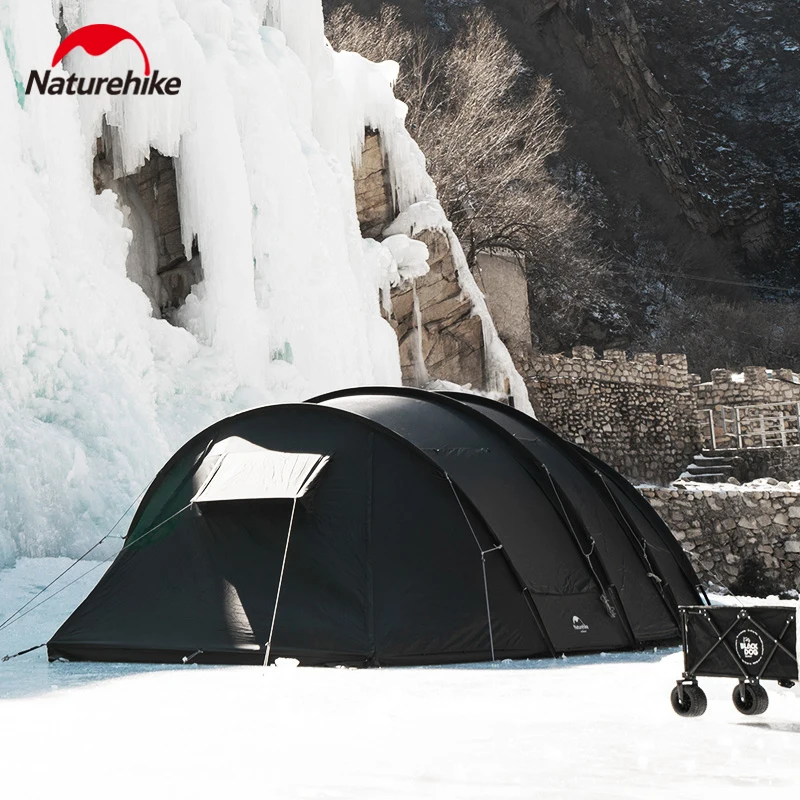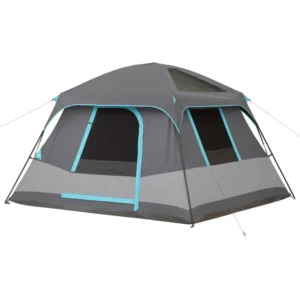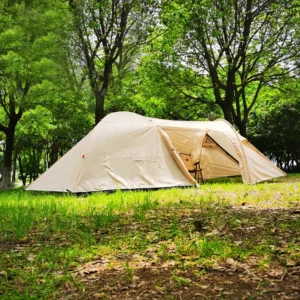Introduction: Understanding the Purpose and Value of Dual Room Tent Designs
Dual room tents represent a significant evolution in outdoor shelter design, offering specialized living spaces with distinct separated areas for different functions. Unlike traditional single-room tents, these innovative shelters provide dedicated zones for sleeping, living, and storage—effectively creating a more home-like experience in the wilderness.
The popularity of dual room tents continues to grow across diverse camping demographics, from families seeking privacy to friend groups wanting shared experiences without sacrificing personal space. Extended-stay campers particularly appreciate these designs for creating a more organized and comfortable base camp during longer outdoor adventures.
What makes these tents truly special is how their design directly impacts your camping experience:
– Thoughtfully arranged spaces enhance comfort and reduce campsite chaos
– Strategic weather protection keeps specific areas dry regardless of conditions
– Functional layouts improve sleep quality and daily living routines
– Well-designed separation reduces conflicts and accommodates different schedules
At Explore Elements, we’ve tested our dual room tent designs across extreme conditions, from scorching desert heat to freezing mountain environments. This real-world testing ensures that these sophisticated outdoor living solutions perform when you need them most.
As we explore the various design options available, you’ll discover how to select a dual room tent that perfectly matches your outdoor living needs, whether you’re a weekend warrior or dedicated wilderness enthusiast. Understanding compact shelters for two campers provides valuable context, especially when considering how two-room tents enhance group camping experiences.
Key Benefits of Well-Designed Dual Room Tents
Privacy Enhancement
Well-designed dual room tents transform the camping experience by offering genuine privacy. Solid divider walls, separate entrances, and thoughtful layout configurations create personal spaces that feel truly distinct. This separation allows family members or friends to change clothes, sleep, or simply enjoy quiet time without disturbing others. Some advanced designs even incorporate sound-dampening materials in divider walls, further enhancing the feeling of having your own space.
Organizational Efficiency
The designated zones in dual room tents significantly reduce the chaos often associated with camping. With dedicated areas for sleeping, cooking/eating, and gear storage, everything has its place. This separation prevents the common frustration of searching through jumbled equipment or sleeping on uncomfortable gear. The most effective designs incorporate transition spaces that prevent tracking dirt and debris from outside directly into sleeping quarters.
Weather Adaptability
One of the most practical advantages of dual room tents is their ability to provide functional spaces regardless of weather conditions. When rain forces everyone inside, having separate areas prevents the cramped feeling of traditional tents. Morning risers can prepare for the day without disturbing late sleepers, and wet gear can be isolated from dry sleeping areas. This adaptability extends your camping season and improves the overall experience during unpredictable weather.
Improved Sleep Quality
Sleep is crucial for enjoyable camping, and key advantages of two-room family tents include numerous sleep-enhancing features. Darkroom technology in sleeping chambers blocks morning light, allowing for better rest. The physical separation between sleeping and living areas reduces noise disruption, while dedicated sleeping zones can be better temperature-controlled. These design elements combine to create a more restful environment than traditional single-room tents.
Group Harmony
Perhaps the most underappreciated benefit is how dual room designs foster better group dynamics. By providing personal space, these tents reduce the irritations that often emerge during extended time together in close quarters. Different sleep schedules become manageable, personal items remain organized, and everyone can enjoy both community and solitude as needed—making for more pleasant camping memories.
Major Architectural Designs for Dual Room Tents
Cabin-Style Designs
Cabin-style dual room tents feature nearly vertical walls that maximize internal usable space, creating a home-away-from-home feeling that’s perfect for families and comfort-focused campers.
- Pros: Excellent headroom throughout, rectangular floor plans efficiently use space, easy room-to-room movement, and strong weather resistance
- Cons: Typically heavier than other designs, larger packed size, and more poles to assemble
- Best for: Extended camping trips, base camping, and family adventures where comfort is a priority
These designs excel in creating distinct living spaces with a familiar residential feel, often featuring large windows and multiple doors for convenient access to each room.
Tunnel Designs
Tunnel tents use a series of parallel hoops to create elongated structures that efficiently balance weight with living space, making them versatile options for various camping styles.
- Pros: Excellent space-to-weight ratio, efficient use of materials, natural division of spaces
- Cons: Require proper staking for stability, typically arranged in linear fashion limiting layout options
- Best for: Campers seeking good space without excessive weight, sites with sufficient room for longer footprints
The sequential room arrangement creates natural zones for different activities, often with a central living area flanked by sleeping quarters at one or both ends.
Extended Dome Designs
These tents begin with a traditional dome structure and add extensions or additional domes to create separate rooms, offering a balance between stability and interior space.
- Pros: Better wind resistance than cabin designs, good headroom in the central area, relatively intuitive setup
- Cons: Sloping walls reduce usable space in peripheral areas, less defined room separation in some models
- Best for: Camping in variable weather conditions where stability matters but interior comfort remains important
Extended dome designs often feature a main dome for common activities with smaller domes or extensions serving as bedrooms or storage areas.
Geodesic Multi-Room Designs
Using complex pole structures with multiple crossing points, geodesic designs offer superior stability in extreme weather while creating multiple interior zones.
- Pros: Exceptional stability in high winds and snow, self-supporting structure, efficient distribution of stress
- Cons: More complicated setup, heavier poles, often more expensive
- Best for: Expedition camping, high-altitude environments, and extreme weather conditions
These designs use advanced architectural principles to withstand serious environmental challenges while still providing separated living spaces.
Inflatable/Air Beam Designs
Modern inflatable tents replace traditional poles with air-filled beams, dramatically simplifying setup while maintaining structural integrity.
- Pros: Extraordinarily fast setup (often under 10 minutes), no pole assembly, good reliability when properly maintained
- Cons: Potential for punctures (though most include repair kits), sometimes heavier than pole designs
- Best for: Campers prioritizing convenience, families with young children, or anyone who values quick setup
These innovative designs have revolutionized family camping by removing the frustration often associated with complex pole assembly.
Modular Designs
The ultimate in customization, modular tent systems allow you to attach or detach rooms as needed for different trips and group sizes.
- Pros: Highly adaptable to different camping scenarios, expandable for growing families, great investment value
- Cons: Connection points can be vulnerable to weather, more complex to configure properly
- Best for: Campers whose group size varies frequently or who camp in dramatically different settings
These versatile systems allow you to pack exactly what you need for each adventure, adding or removing rooms based on your specific requirements.
Browse our selection of two-room camping tents designed for optimal space management and comfort.
Interior Layout Options and Room Configurations
Side-by-Side Configurations
Side-by-side layouts position rooms adjacent to each other, creating an efficient footprint that works well in most campsites. This configuration typically features either equal-sized rooms or a larger master room paired with a smaller secondary space. The entrance may be centrally located to provide equal access to both rooms, or positioned to one side for a more defined primary and secondary space arrangement. This design excels for couples camping with children or two couples seeking similar accommodations.
Front-to-Back Layouts
Front-to-back designs arrange rooms in sequence, creating a linear flow through the tent. This configuration often places sleeping areas at the rear for greater privacy and security, with living or storage space positioned near the entrance. The sequential arrangement provides excellent separation between functions but requires careful consideration of traffic patterns to prevent disturbance when moving through the tent. These layouts work particularly well for families with young children who sleep earlier than adults.
Hub-and-Spoke Designs
One of the most innovative configurations, hub-and-spoke layouts feature a central communal area with separate rooms extending outward like spokes on a wheel. This design maximizes the shared central space while providing distinct private areas around the perimeter. The central hub typically serves as a dining or gathering space, with sleeping pods arranged around it. This arrangement creates excellent separation between sleeping areas, making it ideal for mixed groups of friends or multiple families.
L-Shaped and Irregular Configurations
These non-linear designs optimize function over traditional shape constraints, creating specialized areas for specific needs. L-shaped configurations might tuck sleeping areas away from main traffic paths, while irregular designs can adapt to specific site conditions or user preferences. These creative layouts often feature distinct zones for cooking, dining, sleeping, and gear storage, each shaped according to its function rather than following conventional tent geometry.
Divider Types
The nature of room separation significantly impacts privacy and flexibility:
- Permanent sewn-in walls: Offer maximum privacy and weather isolation between rooms
- Zippered dividers: Provide optional privacy that can be opened for a larger combined space
- Toggle or clip dividers: Allow for quick configuration changes but offer less sound and light isolation
- Roll-away panels: Combine the benefits of complete removal with the convenience of remaining attached to the tent
Understanding tent zoning configurations helps you design your ideal living arrangement based on your specific camping needs.

Functional Design Elements That Enhance Usability
Entrance Design
The number, placement, and style of doors dramatically impact tent livability:
- Multiple entrances reduce traffic and disturbance through sleeping areas
- D-shaped doors offer easy access while minimizing zipper stress
- T-shaped entries provide excellent weather protection during entry/exit
- Panel doors with windows allow light without sacrificing privacy
- Entry placement should align with interior zones to prevent cross-room traffic
Well-placed entrances reduce midnight disturbances and improve overall convenience, especially for families or larger groups.
Window Configuration
Windows balance ventilation, views, and privacy:
- Large mesh windows maximize airflow during warm weather camping
- Adjustable covers allow climate control as conditions change
- Privacy panels enable ventilation without sacrificing seclusion
- Placement at different heights optimizes views while maintaining privacy
- PVC panels provide clear views during inclement weather
Strategic window placement enhances both the functional and psychological comfort of your tent.
Ventilation Systems
Proper airflow prevents condensation and maintains comfort:
- High/low venting creates natural convection airflow
- Mesh ceiling panels release warm air while keeping insects out
- Adjustable roof vents allow fine-tuning regardless of weather
- Door positioning that creates cross-ventilation
- Ground-level vents that reduce humidity from the tent floor
Effective ventilation systems work in all weather conditions to maintain comfort and prevent moisture problems.
Storage Solutions
Integrated storage keeps gear organized and accessible:
- Mesh pockets at different heights accommodate various items
- Gear lofts utilize overhead space for lightweight items
- Built-in clotheslines or hanging points for wet gear
- External attachment points for gear that shouldn’t be stored inside
- Dedicated electronics pockets with cable pass-throughs
Well-designed storage solutions transform how you organize and access your camping essentials.
Flooring Options
Floor design significantly impacts comfort and durability:
- Bathtub floors with high sides prevent water entry
- Reinforced high-traffic areas extend tent lifespan
- Removable floor sections in vestibules or living areas
- Footprint compatibility for additional ground protection
- Seamless construction in sleeping areas for maximum waterproofing
The right flooring design keeps you comfortable and dry regardless of ground conditions.
Vestibules and Covered Extensions
Protected outdoor spaces extend usable areas:
- Cooking vestibules provide sheltered meal preparation space
- Gear storage alcoves keep equipment accessible but protected
- Transitional spaces prevent tracking dirt and water into sleeping areas
- Covered entrances offer shelter during entry/exit in poor weather
- Extendable awnings create additional sheltered outdoor living space
Understanding what is a tent vestibule helps you maximize these valuable transition zones between indoor and outdoor spaces.
Material Selection and Weather Protection Design
| Material Type | Weight | Durability | Weather Resistance | Best Uses |
|---|---|---|---|---|
| Polyester | Light-Medium | Good | Excellent UV resistance, moderate waterproofing | Most camping conditions |
| Nylon | Very Light-Medium | Good | Excellent strength, needs UV protection | Lightweight applications |
| Polycotton/Canvas | Heavy | Excellent | Superior breathability, natural insulation | Long-term camping, extreme conditions |
| Ripstop Variations | Varies | Very Good | Tear-resistant, easily repaired | High-stress applications |
The tent’s weather protection system begins with material selection but extends far beyond basic fabric choices. Waterproofing technology varies significantly, with hydrostatic head (HH) ratings indicating water resistance—ranging from basic 1,500mm protection for fair weather to robust 5,000mm+ ratings for severe conditions. Advanced treatments like silicone impregnation (silnylon/silpoly) offer superior waterproofing with minimal weight penalty, while durable water repellent (DWR) finishes enhance long-term performance.
Frame materials similarly impact tent performance and longevity. Aluminum poles deliver excellent strength-to-weight ratio and superior durability, while fiberglass offers economical performance in moderate conditions. Premium tents often feature aerospace-grade aluminum or carbon composite poles for ultimate strength with minimal weight.
Seam construction represents a critical yet often overlooked aspect of weather protection. Fully taped seams create watertight barriers at fabric junctions, while double-stitched and inverted seam designs add reinforcement at critical stress points. The most weather-resistant designs feature welded seams in high-exposure areas, eliminating needle holes entirely.
Climate-specific adaptations further enhance performance in particular environments. Desert-oriented designs prioritize UV protection and ventilation with lighter rain flies, while wet weather configurations feature extended coverage and additional guy-out points for stability in driving rain.
Our waterproof camping tent collection features advanced weather protection systems tested in real-world conditions.
Seasonal Design Considerations for Dual Room Tents
Summer-Optimized Designs
Warm-weather camping demands designs that prioritize ventilation and heat management:
- Maximum mesh panels for continuous airflow
- Minimal rain fly configurations that can be partially deployed
- UV-resistant materials that prevent fabric degradation
- Extended awnings creating shaded outdoor living spaces
- Multiple door options for cross-ventilation
These designs focus on creating cool, comfortable living spaces during hot conditions while maintaining insect protection.
Three-Season Versatility
The most popular tent classification balances protection across spring, summer, and fall:
- Convertible rainfly systems that adjust to changing conditions
- Balanced ventilation with closable options for cooler weather
- Moderate pole structures that handle occasional wind and rain
- Vestibules sized for three-season gear storage requirements
- Multiple tie-down points for increased stability when needed
These adaptable designs handle most camping conditions while remaining reasonably lightweight and easy to set up.
Extended Season/Four-Season Options
For serious weather protection in harsh conditions:
- Reinforced pole structures with additional crossing points
- Full-coverage rainflies with minimal or no mesh when deployed
- Snow-shedding designs with steeper angles to prevent accumulation
- Protected ventilation systems that function without allowing snow entry
- Interior configurations that maximize heat retention
Our 4-season winter 2-person tents demonstrate these advanced weather-resistance features.
Tropical and High-Humidity Considerations
Specialized designs for hot, wet environments incorporate:
- Elevated floor designs that promote airflow beneath the tent
- Maximum separation between rainfly and canopy to prevent heat buildup
- Quick-drying, mold-resistant materials throughout
- Extended vestibules for wet gear storage away from sleeping areas
- Ground-level vents that function during tropical downpours
Matching Dual Room Tent Designs to Your Specific Needs
What features make a dual room tent best for families with children?
Family-focused designs prioritize safety and supervision with clear sightlines between parent and child sleeping areas. Look for noise-reducing dividers that still allow visual monitoring, child-safe zippers and closures, and protected interior spaces where small children can play during inclement weather. Many family designs feature darkened sleeping rooms to extend morning sleep while allowing early risers to use the main living area without disturbing others.
How should friends or multiple adults choose a dual room configuration?
When camping with other adults, equal room dimensions and separate entrances become particularly important. Privacy-focused designs with solid dividers rather than mesh or partially open separators provide more comfortable shared accommodations. Look for symmetrical layouts where neither sleeping area requires passage through the other, and consider models with convertible common spaces that transform from daytime gathering areas to nighttime sleeping quarters.
What design elements matter most for extended-stay or base camp setups?
For longer camping trips, prioritize standing height throughout the living area, reinforced flooring that withstands continuous use, and advanced storage systems that keep gear organized over time. The most successful extended-stay designs feature multiple rooms with specialized functions—dedicated cooking areas separate from sleeping quarters, changing/privacy spaces, and protected entrances that prevent tracking dirt and debris throughout the tent.
Which dual room features matter most for weekend or occasional campers?
Infrequent campers should prioritize intuitive setup mechanisms, clear instructions permanently attached to the storage bag, and designs that function well even if imperfectly pitched. Quick-deployment systems like unified frame designs or air beam construction significantly improve the occasional camping experience by reducing setup frustration. Choosing the ultimate compact shelter for two involves balancing ease of use with desired features.
Advanced Design Features and Innovations
Modern dual room tents incorporate technologies that transform the camping experience through thoughtful innovation:
Integrated Lighting Systems embed LED strips within tent seams or poles, providing ambient illumination without hanging lanterns. Advanced designs feature zoned lighting controls that allow illumination of specific areas while keeping others darkened for sleep. Some models incorporate light-diffusing panels that eliminate harsh shadows and create more natural interior lighting.
Climate Control Features go beyond basic ventilation with reflective coatings that redirect summer sun or retain winter warmth. Strategic air channeling systems create natural convection currents even in still conditions, while specialized materials react to humidity levels by increasing breathability as moisture levels rise.
Noise Reduction Technologies utilize acoustic dampening materials in room dividers and rain flies to minimize sound transmission between spaces. Physical design elements like offset doorways and staggered sleeping areas further reduce noise disruption, while some premium models incorporate microfiber interior panels that absorb sound within sleeping chambers.
Smart Connectivity features acknowledge modern camping needs with dedicated cable ports, solar panel integration systems, and protected charging stations. These designs separate technology from sleeping areas while keeping devices accessible and protected from the elements.
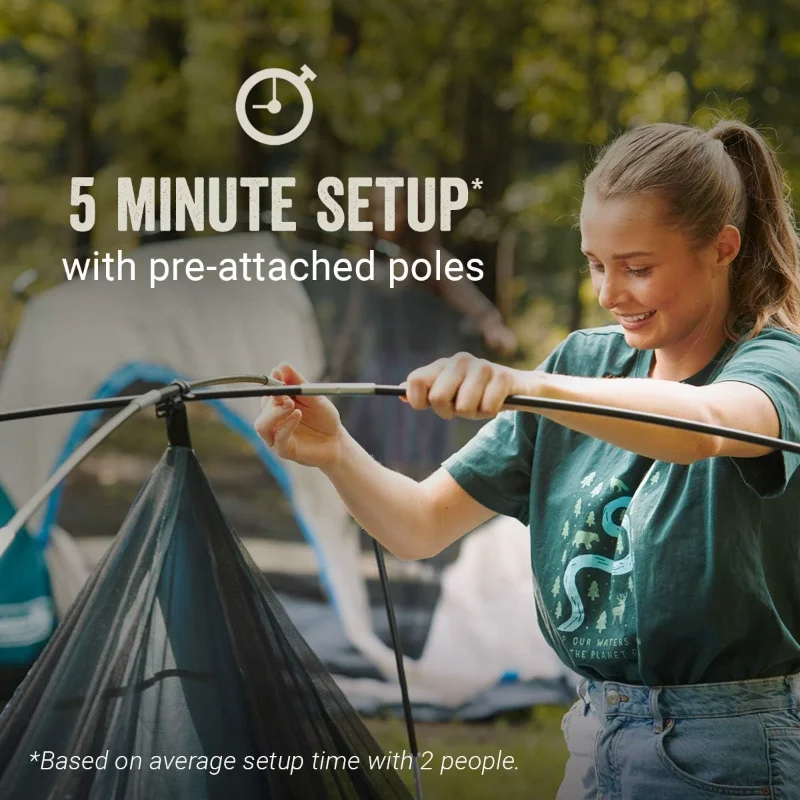
Our easy setup camping tent collection incorporates many of these innovative features while maintaining user-friendly design.
Practical Considerations: Setup, Transport, and Maintenance
Setup Complexity vs. Features
More complex tent designs typically offer enhanced features but require greater setup effort. Consider these practical aspects:
- Color-coded poles and connection points significantly reduce setup confusion
- Unified frame systems require fewer separate assembly steps
- Tent designs requiring two people for setup may offer better stability and space
- Pre-attached guy lines with storage pockets simplify complete weather protection
- Hub-based pole systems typically reduce setup time while maintaining structural integrity
Weight and Packed Size
Dual room tents necessarily weigh more than single-room alternatives, making transport considerations important:
- Divided carrying bags distribute weight between multiple hikers
- Compression straps reduce packed volume for easier transport
- Designs allowing partial setup enable minimum weight configurations
- Removable floors or dividers allow customization based on trip needs
- Separate pole bags provide packing flexibility and protection
Maintenance Requirements
Different designs create varying maintenance needs:
- Tents with fewer seams generally offer better long-term waterproofing
- Accessible zippers with protective covers last significantly longer
- UV-resistant materials reduce the need for special storage precautions
- Modular designs allow replacement of damaged sections rather than entire tents
- Quick-dry materials reduce mildew risk during breakdown and packing
Adaptability
The most practical designs allow configuration changes based on conditions:
- Removable dividers create flexible space arrangements
- Multiple rainfly configurations adapt to changing weather
- Convertible ventilation systems handle varying temperatures
- Repositionable storage features accommodate different gear loads
- Adjustable guy-out points enhance stability in challenging conditions
When considering space requirements, many campers wonder is a 2-person tent actually big enough for comfortable extended use.
Tall / Stand Up Camping Tent, Two Room Camping Tent
$407.93 Select options This product has multiple variants. The options may be chosen on the product pageHeavy Duty 4 Season Tent, Mountaineering Tent, Winter Camping Tent
$870.40 Select options This product has multiple variants. The options may be chosen on the product pageCompact Backpacking Tent, Lightweight Backpacking Tent, Waterproof Camping Tent
$335.52 Select options This product has multiple variants. The options may be chosen on the product pageUltralight Backpacking Tent, Ultralight Dome Tent, Winter Camping Tent
Price range: $369.63 through $370.07 Select options This product has multiple variants. The options may be chosen on the product pageCamping Tent with Vestibule, Waterproof Camping Tent
Price range: $407.89 through $479.48 Select options This product has multiple variants. The options may be chosen on the product pageHeavy Duty 4 Season Tent, Ultralight Freestanding Tent, Winter Camping Tent
$3,722.66 Select options This product has multiple variants. The options may be chosen on the product page
How to Evaluate Dual Room Tent Designs: A Buyer’s Guide
Size vs. Stated Capacity
□ Multiply stated capacity by 20-25 square feet per person for realistic comfort
□ Add 15-20% additional space for gear storage requirements
□ Consider width dimensions for sleeping arrangements (standard sleeping pads are 20-25 inches wide)
□ Verify headroom throughout the tent, not just at the center peak
□ Check room dimensions against your specific sleeping equipment
Manufacturer capacity ratings typically represent the maximum number of people who can sleep shoulder-to-shoulder with minimal gear. For comfortable dual room living, especially for trips longer than a weekend, sizing up at least one person from the manufacturer’s rating provides significantly better comfort.
Weather Resilience
□ Match pole structure to expected wind conditions (more crossing points = better stability)
□ Verify rainfly coverage extends fully to the ground for serious weather protection
□ Check waterproof ratings (1500mm minimum, 3000mm+ for reliable protection)
□ Confirm all seams are taped or sealed, particularly on the floor and rainfly
□ Assess guy line attachment points (more points = better stability in wind)
The weather protection system must function as a unified whole. A tent with excellent waterproofing but poor ventilation will create interior condensation, while a stable structure with inadequate waterproofing will leak during sustained rain.
Ventilation Effectiveness
□ Identify high/low ventilation options that work with the rainfly installed
□ Verify mesh panels are appropriately sized for your typical camping climate
□ Confirm ventilation options in sleeping areas can be adjusted without leaving bed
□ Check that door and window configurations allow cross-ventilation
□ Ensure vestibules have ventilation to prevent condensation on stored gear
Effective ventilation must function in all weather conditions, not just when the sky is clear. The best designs include protected venting that works during rainfall.
Setup Complexity
□ Realistically assess your patience and experience with tent assembly
□ Consider who will typically help with setup (solo, partner, family)
□ Check if critical steps require specific heights or strength levels
□ Verify all components can be replaced if damaged
□ Test setup instructions for clarity before backcountry use
Setup difficulty increases exponentially in adverse conditions like darkness, rain, or high winds. Choose a design you can confidently assemble under challenging circumstances.
Weight-to-Feature Ratio
□ Determine your transportation method (car camping vs. carrying)
□ Identify features you’ll use regularly versus rarely
□ Consider modular components that allow packing only what you need
□ Check if components can be divided among multiple packs
□ Assess packed size against your specific storage and transport constraints
The ideal balance prioritizes features you’ll use frequently while minimizing those that add weight without enhancing your specific camping experience.
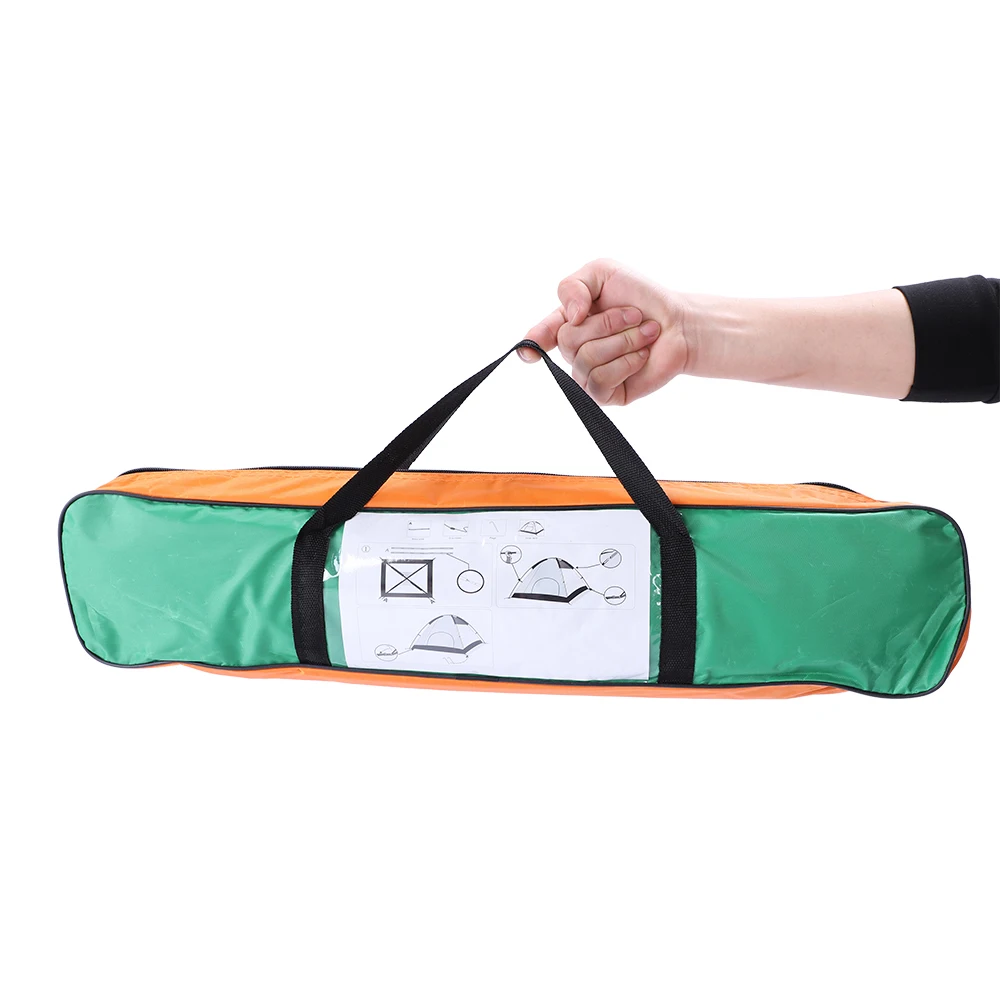
Our dome camping tent options offer excellent space efficiency with reliable weather protection.
Frequently Asked Questions About Dual Room Tent Designs
What is the most weather-resistant dual room tent design?
Geodesic and extended dome designs typically offer superior weather resistance due to their intersecting pole structures that distribute stress efficiently. These designs perform better in high winds and heavy snow loads compared to cabin styles with vertical walls. For maximum weather protection, look for designs with multiple pole crossing points, full-coverage rainflies, and additional guy-out options to stabilize the structure during storms.
Can dual room tents be used for backpacking, or are they too heavy?
While most dual room tents are designed for car camping or base camping, ultralight options do exist for backpackers willing to divide components among group members. These specialized lightweight designs typically use minimal pole structures with high-tension guy lines and ultralight materials. They sacrifice some convenience features but can reduce weight to manageable backpacking levels when the privacy and organization benefits outweigh the weight penalty.
How do I choose between permanent or removable room dividers?
This decision depends primarily on your typical camping group. Families with young children often prefer removable dividers that allow visual monitoring while still creating separate spaces. Adult groups typically benefit from more substantial dividers for true privacy. Consider noise factors (do some campers snore?), light sensitivity differences, and whether group composition changes frequently. Removable dividers offer versatility but typically provide less sound and light isolation than permanent walls.
What design features are most important for family camping with small children?
Family-focused designs should prioritize darkroom technology in sleeping areas to extend morning sleep, easy-clean flooring materials that withstand spills, simplified zipper systems that children can operate, and protected interior spaces where kids can play during inclement weather. Additional family-friendly features include interior height sufficient for parents to stand when helping children, and strategic divider placement that allows parental supervision without constant disturbance.
Are inflatable dual room tents as durable as traditional pole designs?
Modern air beam technology has significantly improved, making quality inflatable tents comparable in durability to traditional pole designs in most conditions. High-pressure air beams maintain rigid structure similar to poles, with the additional advantage of flexing without breaking in high winds. The key vulnerabilities are punctures (though most include repair kits) and potential pump failure. Many premium inflatable tents now use multiple independent air chambers to prevent complete collapse if one section is compromised.
What’s the difference between a “2-room” and “2-person” tent?
These terms refer to completely different specifications. A “2-room” tent features separate living spaces divided by some type of wall or partition, regardless of overall capacity. These tents may accommodate anywhere from 2 to 8+ people depending on size. A “2-person” tent indicates capacity—designed to sleep two adults—and typically consists of a single undivided space. Understanding camping shelter options for two helps clarify these important distinctions.
Future Trends in Dual Room Tent Design
The evolution of dual room tents continues with several exciting developments on the horizon:
Sustainable Materials are transforming tent production with recycled fabrics, biodegradable waterproofing treatments, and reduced chemical usage. New manufacturing processes significantly lower environmental impact while maintaining or improving performance characteristics. Watch for increased transparency in material sourcing and production methods as sustainability becomes a core design consideration.
Ultralight Multi-Room Options challenge the assumption that separated spaces must mean heavy designs. Innovative pole structures, advanced fabrics, and minimalist-yet-effective divider systems are creating truly backpackable dual room options. These designs prioritize function over luxury features while maintaining essential separation and organization benefits.
Enhanced Customization goes beyond basic modularity with connector systems that accommodate different tent combinations based on specific needs. These systems allow mixing components from different models to create custom configurations, with standardized connection points ensuring weather-tight integration regardless of the components used.
Climate-Adaptive Technologies incorporate materials that actively respond to environmental conditions. Fabrics that increase breathability as humidity rises, thermal properties that adjust to temperature fluctuations, and coating systems that enhance water repellency during sustained rainfall represent the cutting edge of tent material science.
These developing trends suggest that future dual room tents will offer even greater versatility, performance, and environmental responsibility—continuing the remarkable evolution of these specialized outdoor living spaces.

